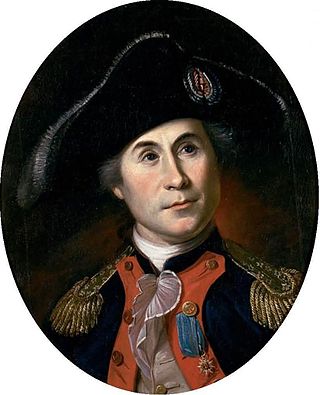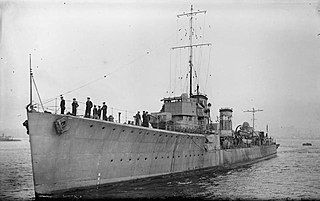Serapis is a Greco-Egyptian god.
Serapis may also refer to:
- HMS Serapis, various British ships
- USS Serapis, several US ships
Serapis is a Greco-Egyptian god.
Serapis may also refer to:

John Paul Jones was a Scottish American naval captain who was a naval commander in the American Revolutionary War. Often called the "Father of the American Navy", a title sometimes also credited to John Barry, John Adams, and sometimes Joshua Humphreys, Jones is highly regarded as one of the greatest naval commanders in the history of the United States.

HMS Serapis was a Royal Navy two-decked, Roebuck-class fifth rate. Randall & Brent built her at Greenland South Dockyard, Rotherhithe and launched her in 1779. She was armed with 44 guns. Serapis was named after the god Serapis in Greek and Egyptian mythology. The Americans captured her during the American War of Independence. They transferred her to the French, who commissioned her as a privateer. She was lost off Madagascar in 1781 to a fire.
Five ships of the Royal Navy have been named HMS Serapis, after the god Serapis of Hellenistic Egypt.
USS Vengeance has been the name of two ships in the United States Navy.

Bonhomme Richard, formerly Duc de Duras, was a warship in the American Continental Navy named for Founding Father Benjamin Franklin. She was originally an East Indiaman, a merchant ship built in France for the French East India Company in 1765, for service between France and Asia. She was placed at the disposal of John Paul Jones on 4 February 1779, by King Louis XVI of France as a result of a loan to the United States by French shipping magnate Jacques-Donatien Le Ray.
Nathaniel Fanning was an officer in the Continental Navy and later the United States Navy, who served aboard Bonhomme Richard during its 1779 battle with HMS Serapis.

HMS Serapis was a Euphrates-class troopship commissioned for the transport of troops to and from India. She was launched in the Thames on 26 September 1866 from the Thames Ironworks and Shipbuilding Company at Leamouth, London and was the third Royal Navy ship to bear the name. She was sold in 1894.

Serapis or Sarapis is a Graeco-Egyptian god. A syncretic deity derived from the worship of the Egyptian Osiris and Apis, Serapis was extensively popularized in the third century BC on the orders of Greek Pharaoh Ptolemy I Soter, as a means to unify the Greek and Egyptian subjects of the Ptolemaic Kingdom.

The Battle of Flamborough Head was a naval battle that took place on 23 September 1779 in the North Sea off the coast of Yorkshire between a combined Franco-American squadron, led by Continental Navy officer John Paul Jones, and two British escort vessels protecting a large merchant convoy. It became one of the most celebrated naval actions of the war in America, despite its relatively small size and a considerable dispute over what had actually occurred.
USS Serapis (IX-213) was a single-screw tanker that served for a short time as a floating storage tanker for the United States Navy at the end of World War II.

Serapis is a name given to an unconventional, early United States ensign flown from the captured British frigate Serapis.
USS Serapis may refer to the following ships operated by the United States Navy:

Sir Richard Pearson (1731–1806) was a British naval officer who was captain of the ship HMS Serapis during the American Revolution.

The Euphrates class was a five-ship class of iron screw troopships built for the Royal Navy during the 1860s. They were used for carrying troops to India, with two of them being later hulked and surviving into the early 20th Century.
Events from the year 1779 in the United States.
HNLMS Piet Hein may refer to following ships of the Royal Netherlands Navy:

HMS Serapis was an S-class destroyer of the British Royal Navy. The ship was built by Scotts Shipbuilding and Engineering Company from 1941 to 1943, and was launched on 25 March 1943 and completed on 25 December 1943.

HMS Serapis was an S-class destroyer, which served with the Royal Navy during the Greco-Turkish and Russian Civil Wars. Launched on 17 September 1918, the vessel was not completed until after the closing of the First World War. The ship joined the Seventh Destroyer Flotilla in the Reserve Fleet at Rosyth. The ship was then commissioned and sent to Constantinople to support refugees escaping from the conflicts in the Black Sea. The destroyer assisted in the evacuation of the Crimea in 1919 and helped rescue about nine hundred people from Smyrna in 1922. In 1929, Serapis was transferred to Hong Kong to serve in China. However, the signing of the London Naval Treaty in 1930 meant that the Royal Navy looked to retire older vessels. Serapis was sold to be broken up on 25 January 1934.

HMS Serapis was a fifth-rate ship of the Roebuck class designed by Sir Thomas Slade for use in the shallow coastal waters around North America. She was ordered for the Royal Navy in 1780, during the American Revolutionary War, and was 886 46⁄94 tons (bm) as built. When fully armed, she would have a battery of 20 x 18-pounder (8.2 kg) long guns on the lower deck and 22 x 12-pounder (5.4 kg) guns on the upper deck, but much of her service was as a transport or storeship, carrying only the 12 pound guns on her upper deck.